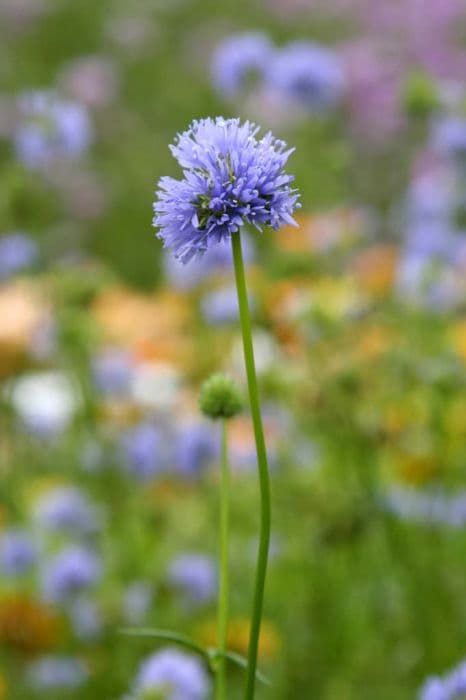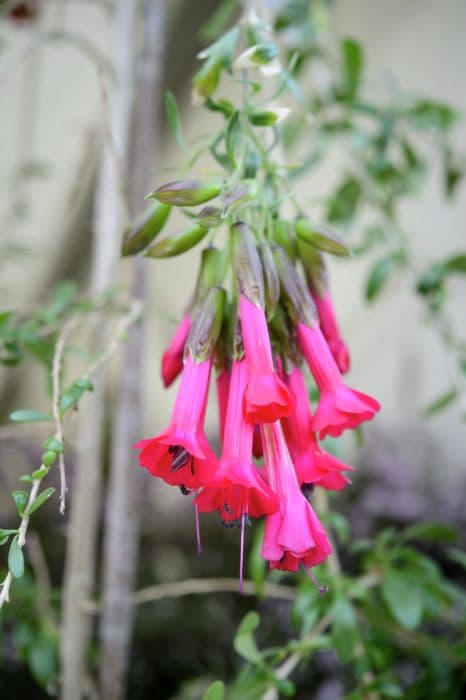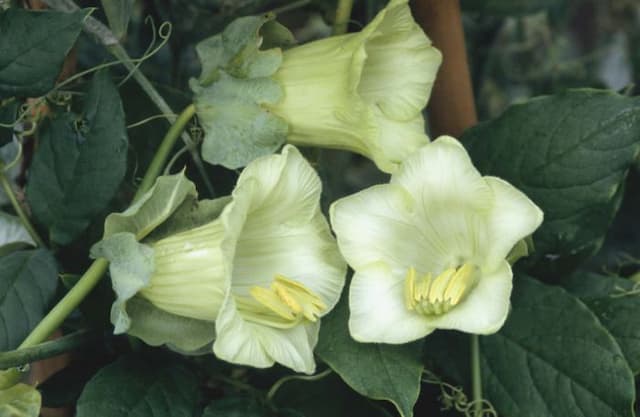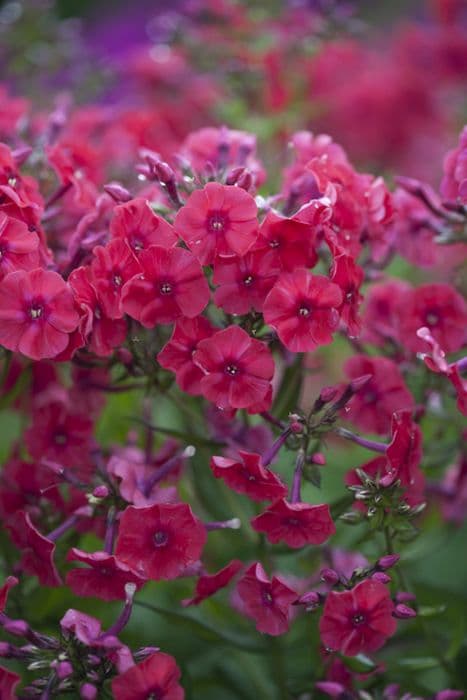Woodland Phlox Phlox divaricata
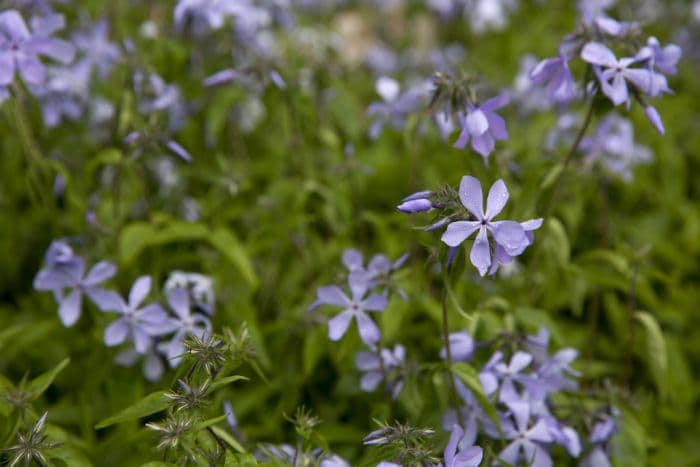
ABOUT
Known commonly as wild blue phlox or woodland phlox, this plant displays a charming and delicate demeanor. Bearing a profusion of soft bluish or violet petals, each wild blue phlox flower is arranged in a rounded, five-petaled form that graces the plant in a captivating, star-like pattern. The flowers cluster at the stem tips, creating a billowy appearance that adds to the plant's ethereal quality. The leaves, which clothe the stems lushly, are lance-shaped and provide a verdant backdrop that contrasts the lighter-hued blossoms. When in full bloom, the wild blue phlox exudes a subtle and sweet fragrance that wafts through woodland gardens, beckoning pollinators and delighting passersby. Despite its fragile looks, it is a hardy plant that weaves an enchanting carpet of color in the shaded areas where it thrives.
About this plant
 Names
NamesFamily
Polemoniaceae
Synonyms
Wild Blue Phlox, Woodland Phlox, Wild Sweet William, Louisiana Phlox
Common names
Phlox divaricata var. divaricata, Phlox canadensis, Phlox ovata.
 Characteristics
CharacteristicsLife cycle
Perennials
Foliage type
Deciduous
Color of leaves
Green
Flower color
Lavender
Height
1 foot (0.3 meters)
Spread
2 feet (0.6 meters)
Plant type
Herb
Hardiness zones
3
Native area
Eastern North America
Benefits
 General Benefits
General Benefits- Attracts Pollinators: Phlox divaricata is known for its ability to attract bees, butterflies, and other pollinating insects, which is beneficial for the garden ecosystem.
- Low Maintenance: Woodland phlox is considered a low-maintenance plant, needing minimal care once established, which makes it ideal for gardeners of all skill levels.
- Aesthetic Appeal: With its beautiful and fragrant flowers, it adds aesthetic appeal to gardens and landscapes.
- Naturalizes Easily: Woodland phlox can spread and naturalize in appropriate conditions, filling in spaces and creating a carpet of color.
- Shade Tolerance: It is well-suited for shaded or semi-shaded areas, making it a versatile choice for different garden settings.
- Drought Resistance: Once established, it can tolerate periods of drought, reducing the need for frequent watering.
- Wildlife Habitat: It provides a habitat and food source for wildlife, including nectar for hummingbirds.
- Seasonal Interest: Woodland phlox offers seasonal interest in the spring and early summer when it blooms.
- Erosion Control: It can help prevent soil erosion when planted in groups or as ground cover on slopes.
 Medical Properties
Medical PropertiesThis plant is not used for medical purposes.
 Air-purifying Qualities
Air-purifying QualitiesThis plant is not specifically known for air purifying qualities.
 Other Uses
Other Uses- Wildlife Habitat: Phlox divaricata provides nectar for hummingbirds and butterflies, enhancing biodiversity in a garden.
- Erosion Control: Its mat-forming habit helps stabilize soil in sloped gardens or along stream banks.
- Education: Often used in schools or educational programs to teach botany and plant lifecycle to students.
- Natural Dye: Historically, some species of phlox may have been used to create natural dyes for fabrics.
- Garden Design: Used for its aesthetic appeal in moon gardens because of its light-colored flowers that are visible at dusk.
- Companion Planting: Can be planted alongside vegetables in a garden to attract pollinators, which can increase vegetable yields.
- Aromatic: The flowers can be used in potpourris or as a natural air freshener due to their fragrance.
- Culinary: Edible flowers can be used as garnishes or to add a subtle flavor to salads (note: always verify the edibility of specific plant parts before consumption).
- Traditional Ceremonies: In some cultures, the flowers may be used for decorative purposes in ceremonies or traditional events.
- Crafts: Dried phlox flowers can be incorporated into crafts, such as homemade paper or flower arrangements.
Interesting Facts
 Feng Shui
Feng ShuiThe Woodland Phlox is not used in Feng Shui practice.
 Zodiac Sign Compitability
Zodiac Sign CompitabilityThe Woodland Phlox is not used in astrology practice.
 Plant Symbolism
Plant Symbolism- Harmony - Phlox divaricata, commonly known as wild blue phlox, often symbolizes harmony due to its clusters of flowers that grow together in unison, representing unity and a smooth blending of personalities within a group.
- Agreement - This connection to agreement stems from its natural propensity for creating a carpet of color in woodlands, which can be seen as a visual metaphor for consensus and accord.
- Sweet Dreams - The wild blue phlox is also associated with sweet dreams, owing to its gentle and calming fragrance that’s prominent at night, which is thought to inspire peaceful sleep and pleasant dreamscapes.
- Proposal - In the language of flowers, presenting someone with phlox could signify a proposal or an offer of marriage, as it suggests a desire for unity and deep connection.
 Water
WaterWoodland phlox should be watered regularly, especially during its blooming period in spring and summer. Aim to keep the soil evenly moist but not waterlogged. Water the plant deeply once a week, providing about one inch of water which equates to approximately 0.6 gallons per square yard of soil. Adjust frequency to account for rainfall and during hot, dry periods, increase watering to twice a week ensuring that the soil does not dry out completely between watering sessions. It’s important not to let the plant sit in water as this can lead to root rot.
 Light
LightWoodland phlox thrives in partial to full shade conditions. It is ideal to place the plant in a spot where it receives filtered sunlight or morning sun with afternoon shade. Avoid exposing woodland phlox to the full, harsh afternoon sun as this can stress the plant and cause foliage burn. The plant's natural understory habitat makes it well-suited for shaded gardens and areas under tall trees or on the north side of buildings.
 Temperature
TemperatureWoodland phlox is hardy and can withstand a temperature range from approximately 60 to 85 degrees Fahrenheit as its ideal growing condition. It can survive minimum temperatures down to about -30 degrees Fahrenheit, which corresponds to USDA hardiness zones 3 to 8. To ensure the best growth and flowering, protect woodland phlox from extreme heat by providing adequate shade or mulch to keep the roots cool.
 Pruning
PruningRegular pruning is beneficial for woodland phlox to encourage denser growth and more abundant blooms. Prune the plant in early spring before new growth starts by cutting back any dead or diseased stems from the previous year. After the flowering season, deadhead spent blooms to promote a second flowering and to maintain a tidy appearance. Pruning is also the time to thin out any overcrowded areas to enhance air circulation, which helps prevent disease.
 Cleaning
CleaningAs needed
 Soil
SoilWoodland Phlox prefers fertile, well-drained soil with a pH range of 5.8 to 7. The ideal soil mix should consist of garden soil, compost, and leaf mold or pine bark to ensure good drainage and fertility.
 Repotting
RepottingWoodland Phlox generally does not need frequent repotting; it can thrive outdoors in the ground. When grown in containers, repotting every 2 to 3 years is sufficient to refresh the soil and accommodate root growth.
 Humidity & Misting
Humidity & MistingWoodland Phlox tolerates a range of humidity levels but thrives in conditions that mimic its native woodland habitat, with moderate to high humidity being ideal.
 Suitable locations
Suitable locationsIndoor
Place Woodland Phlox by a bright window; keep soil moist, not soggy.
Outdoor
Ensure partial shade, good soil, adequate water, and protect from midday sun.
Hardiness zone
3-8 USDA
 Life cycle
Life cyclePhlox divaricata, commonly known as Woodland phlox, starts its life cycle when seeds germinate in the spring after experiencing cold winter temperatures that break their dormancy. Seedlings establish a rosette of leaves at the soil surface and develop a root system. As the plant matures, it grows upright stems and produces lance-shaped leaves. In late spring to early summer, Woodland phlox blooms, showcasing fragrant flowers that range in color from pale blue to lavender, providing nectar for pollinators like butterflies and hummingbirds. After pollination, typically by insects, the plant sets seed in small capsule-like fruit that are then dispersed, sometimes by wind or by animals. The plant is perennial, dying back to the ground in the fall and re-emerging from its root system in the following spring.
 Propogation
PropogationPropogation time
Spring to early summer
The most popular method for propagating Phlox divaricata, commonly known as Wild Blue Phlox or Woodland Phlox, is through division. This process is typically done in early spring or early fall when the plant is not in full bloom, to reduce stress on the plant. To propagate by division, the gardener digs up the Phlox, making sure to retain a good amount of the root system, and then gently separates the plant into smaller sections, each with several shoots and a portion of root attached. These sections can then be replanted immediately in well-prepared soil, spaced approximately 12 to 18 inches (about 30 to 45 centimeters) apart to allow adequate room for growth. Regular watering is essential until the new divisions are established. This method of propagation not only helps to create more plants but also rejuvenates older clumps that may have become woody or less vigorous over time.
